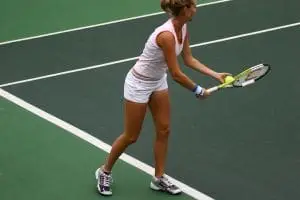
- Tennis Elbow (cumulative) is a condition in which the tendons holding the forearm to the outside of the elbow become damaged and accrue small tears. This is caused by a combination of overusing the forearm extensor muscles and the repeated impact of the ball.
Prevention Tips: Lessen the strength of the ball’s impact on your elbow by practicing correct technique, increasing your muscle strength, and developing muscle flexibility. All of these strategies will help absorb the shock of the ball hitting the racket, so that it doesn’t deflect to the tendons. Additionally, taking shots two-handed instead of single-handed or using a racket with a bigger head and looser strings will help distribute the impact more evenly.
- Rotator Cuff Tendonitis (cumulative) is an inflammation of the shoulder muscles which results from overuse of the muscles and tendons connecting the shoulder blade and the upper arm.
Prevention Tips: This condition is most often caused by improper serving technique in which the arm does not extend upwardly enough. Ideally, it should be at least at a 135 degree angle to the body, with the elbow up higher than the shoulder.
- Wrist Tendonitis (acute and cumulative) is an inflammation of the wrist when its tendons are damaged. This most often occurs as a result of overuse and improper technique which puts more stress on the wrist than usual.
Prevention Tips: Make sure to use the neutral L-shape grip, in which the tennis racket and your forearm are perpendicular, forming the letter “L”. If your wrist begins to hurt (due to an acute injury) give it some rest and let it recover fully before starting to play again. Don’t ignore the pain – if you decide to play through it, the acute injury may become a chronic one.
- Back Pain (acute) is caused by high stress on the back affecting the small joints, lumbar discs, ligaments, tendons, and even muscles around the spine. These parts of the back are constantly under since they’re responsible for the sudden start-and-stop lateral movements of the player.
Prevention Tips: When playing, try not to over-arch your back on a power serve. When you’re off the court, you can still work to prevent this injury by strengthening your back and core muscles and developing their flexibility. This will alleviate stress on the spine’s small joints and the lumbar discs during play.
Long play without pause or stretching leads to a tightening and “shortening” of the arm muscles, which then can’t as easily absorb the shock from hitting the ball. Always taking a shot with the same arm puts too much stress on it specifically – the impact can be reduced by sharing the shot between two hands instead of one or using a racket with a bigger head and looser strings that help absorb the ball’s energy more evenly.
Play it safe. In addition to the tips above, keep these 5 Golden Rules in mind and you will be well on your way to playing tennis without letting injuries slow you down:
- Follow Proper Technique
- Develop Flexibility
- Build Strength
- Increase Endurance
- Up Your Training Gradually

